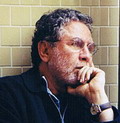The Michel Kikoine Prize
The Michel Kikoïne Prize – a gift of the artist's daughter, Mrs. Claire Maratier-Kikoïne of Paris – is given to encourage and reward Israeli artists. The prize is awarded annually since 2008 in the month of May, shortly before Michel Kikoïne's birth date (May 31, 1892).
The members of the Prize Committee are Prof. Mordechai Omer, Curator of the University Art Gallery; the art collector Doron Sebbag; the journalist and art critic Angela Levine; the artist Ofer Lellouche; and Dr. Catherine Supé- Kikoïne, who represents the Kikoïne family.
The prize ceremony is one of the events attended by Tel Aviv University's Internationsl Board of Governors, in conjunction with the French Friends of Tel Aviv University.
The prize is given to fund an exhibition at the Michel Kikoïne Foundation, and the Genia Schreiber University Art Gallery.
Michel Kikoïne (1892–1968) was born in Belarus and lived in Paris, and was one of the best-known artists affiliated with the School of Paris. Michel Kikoïne and the other members of the School of Paris occupy an important place in the history of 20th century art.
A rich collection of his works, donated by his daughter, Mrs. Claire Maratier- Kikoïne, Kikoïne is on permanent display in the Michel Kikoïne Foundation gallery. The foundation, which has also been donated by Mrs. Claire Maratier- Kikoïne, is an integral part of the University Art Gallery.

The new works of Yehuda Porbuchrai are suffused by an acute awareness of death. Yet death is present in them neither as a threatening shadow nor as a horrifying and omnipresent void. It appears as a form of annihilation, yet simultaneously also as a moment of creation bound up with the recognition that every ending contains a new beginning. This understanding is embodied in the recurrent motif of the exploding nucleus, which embodies the ambivalent potential of both creation and destruction. The possibility of their simultaneous unfolding leads Porbuchrai to explore cosmic expanses and realms suspended between heaven and earth. This is the space in which we witness the momentary blazing of a shimmering nucleus, or an explosion that produces energy circles and beams of light. Yet this type of event never heralds destruction and calamity, never appears as a terrible apocalypse. Rather, it represents a constant flux in the universe, in the context of which individual existence is inevitably presented as a unique presence, a spark that flares up and eventually dies down, swallowed into infinity; a single, private act of living that is kindled and then collapses into an immeasurable, unknowable expanse. Porbuchrai's recognition of the relationship between individual existence and infinity attempts to touch upon the unknown, of which death is one of the central manifestations.
As he reflects on its form, Porbuchrai builds on different scientific disciplines, on the theory of chaos and on fractals – those natural geometric shapes whose form can be endlessly divided into fragments that remain self-identical. Fractals are capable of explaining patterns of chaos, and of partially introducing order into them, yet they remain examples of unpredictability. The heart of chaos thus contains a form of wholeness – a combination of the controllable and the unforeseeable, of order and disorder, of the knowable and the unknowable. The perception of the universe as such a fusion of chaos and wholeness enables Porbuchrai to experience and transmit a chaotic whole, in which distinct entities operate as contrasting forces. This is not a Romantic, transcendental experience that attempts to unite with the infinite by doing away with any sense of separateness, but rather one involving an acceptance of infinity as that which cannot be defined and controlled – as the richness, complexity and vitality associated with uncertainty.
The cosmic landscapes, which signify or capture some kind of event and point to a world beyond the painting, simultaneously refer to the act of painting itself, to the act of inscribing and to the consciousness of the artist creating the sign. The biomorphic shapes appear as a direct expression of hidden themes in human consciousness, while the pictograms resemble a form of shorthand representing thoughts and associations, and the gestural brushstrokes communicate emotions and sensations. Taken together, they reflect the artist's consciousness back to himself. The bare painterly signs form images and structure space, while simultaneously wrecking havoc and allowing for spontaneous, chance occurrences to introduce random, uncontrollable elements. A sense of uncertainty infiltrates these works not only as a basic aspect of the world but also as a source of creation, stemming from a chaos that is at once a beginning and an ending, creation and destruction.
In honor of Yehuda Porbuchrai winning the prize, his exhibition Yehuda Porbuchrai: Recent Works opened on the 6th of May 2010 at the Geneia Schreiber University Art Gallery and Michel Kikoïne Foundation.

